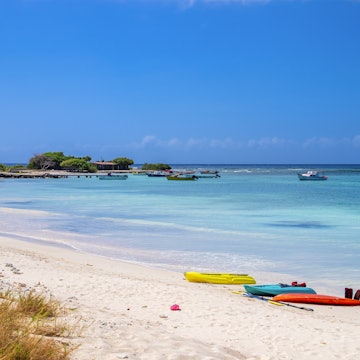

The asado is an essential part of Argentinian culture © Pollyana Ventura / Getty Images
While rich beef and sumptuous malbec are Argentina’s best-known specialties, there is more to the country’s food-and-drink scene than perfectly grilled steak and red wine.
Due in part to the immigration of millions of Europeans to Argentina at the turn of the 20th century, the country brings together European traditions with a distinct South American twist: Italian-style ice cream, empanadas from Spain, wine from vineyards planted by the French and German-style sausages and cheese – plus yerba mate, a herbal tea that is native to South America.
What’s more, a country as large as Argentina, it’s no surprise that each region has its own delicious specialties.
Read on for a guide on how savor every flavor across Argentina.
1. Savor grilled beef at an asado on an estancia
Argentinians are the biggest consumers of beef in the world, and red meat is an essential part of the country’s culture.
Grilling steaks is a tradition rooted in the mythologized gauchos who roamed the pampas (grasslands) tending to cattle and slow-roasting meat over an open flame – a custom ritualized in the form of the asado (or barbecue).
Asados don’t get more traditional than at an estancia (ranch), which you can reach via a day trip (día del campo) from Buenos Aires, or get to know better during an overnight stay.
Where to try it: A visit to El Ombú de Areco or nearby La Bamba de Areco, both in Buenos Aires province, offers an insight into traditional gaucho life, including a typical asado. In Patagonia, Nibepo Aike in El Calafate is a sheep farm where the nightly asado features the local specialty, Patagonian lamb.
Read more: Local Bites: the best places to eat and drink in Buenos Aires

2. Sip mate, Argentina’s quintessential hot drink
Go to any park or plaza and you’ll see people drinking mate, an infusion of yerba (a local, bitter herbal tea) and hot water that is sipped through a special metal straw (a bombilla).
The gourd that holds the yerba and water is called a mate, and the act of drinking from it is tomando mate (drinking mate). The concoction is heated to 70–85°C (160–185°F) but never boiled; a thermos flask keeps it warm on the go.
Where to try it: Mate is not typically served in bars or restaurants, so make friends and join in the mate ritual in a park or street corner. A good place to shop for an artisan mate gourd is the Feria de San Telmo (a Sunday street market) in Buenos Aires.
Read more: How to drink mate in Argentina
3. Tuck into an empanada, Argentina’s favorite snack
Oven-baked pastries with various savory fillings, empanadas are a staple of the traditional Argentine diet and the equivalent of a lunchtime sandwich (a mealtime portion usually consists of three).
Empanadas are popular throughout Argentina, and have several regional variations. Look out for spicy ground-beef empanadas in Salta and Jujuy, deep-fried empanadas from Tucumán and lamb-filled empanadas in Patagonia.
Where to try it: In Bariloche, try the creative flavors on offer at Oveja Negra. Salta is reputed to be home to Argentina’s best empanadas; try them at La Salteñería. In Buenos Aires, you can’t go wrong at La Morada.

4. Get your meat-on-the-go fix at a parrilla food stand
For a hit of protein to go, stop by a roadside mobile parrilla (grill) for choripán, a grilled sausage sandwich, or bodiola, a pork sandwich.
These rustic food trucks offer generous helpings of grilled meat in jaw-bustingly thick crusty bread, with self-service Tupperware containers of chimichurri, a sauce made from garlic, parsley, oil and vinegar.
Where to try it: In Buenos Aires, brightly colored food carts line the Costanera Sur in Puerto Madero and the Costanera Norte near Jorge Newbery airport.

5. Stop for afternoon tea in an elegant Buenos Aires cafe
Since it’s rare to eat the main meal of the day before 9pm in Argentina (11pm dinners are not uncommon), visitors can stave off growling stomachs by pausing for la merienda (afternoon tea) sometime between 4pm and 6pm.
A classic merienda consists of a milky coffee and a few medialunas (croissants).
Late afternoon is the perfect time to visit one of Buenos Aires’ traditional bares notables, a group of beautiful old cafes where sandwiches de miga (crustless sandwiches) and facturas (pastries) are served with considerable pomp by bow-tied waiters.
Where to try it: With magnificent stained-glass windows, Las Violetas has been serving afternoon tea to the residents of Buenos Aires’ Almagro neighborhood since 1884. A traditional Argentinian bar that’s popular with a young crowd and newspaper-reading septuagenarians alike, Los Galgos is the perfect choice if your ideal merienda includes an early-evening cocktail. For the most luxurious afternoon tea in the city, head to L’Orangerie at the Alvear Palace Hotel.
6. Drink Fernet with Coke, Argentina’s national party drink
In Argentina, Fernet-Branca – a bitter, herbal Italian digestif originally intended as medicine – is usually consumed with ice and cola, for a mixture of alcohol, sugar and caffeine that helps fuel Argentina’s famously late nights out.
The combination of Fernet with Coke first became popular in the province of Córdoba, where the Fernandito cocktail remains a local favorite.
Where to try it: Most bars and clubs in Argentina serve Fernet. In Buenos Aires, try it in Pulpería Quilapán.

7. Cool off with ice cream in a traditional heladería
A tasty legacy of Italian immigration to Argentina is the country’s excellent gelato. It’s common for city center heladerías (ice cream parlors) to stay open until 1am or 2am; a late-night stop for ice cream makes for a romantic and refreshing excursion.
Local food and drink to try include sambayón, made with egg yolks, Marsala wine and sometimes whisky; and dulce de leche, made with the popular milk caramel.
Where to try it: For a post-beach ice cream in Mar del Plata, head to Helados Italia, known for its “cannolis” (long wafer tubes filled with ice cream then dipped in chocolate and nuts). Cadore makes ice cream the traditional Italian way on Avenida Corrientes, in Buenos Aires’ theater district. The family recipes used at Heladería Fili in Salta are a closely guarded secret. Rosarinos (people from Rosario) insist their city’s ice cream is Argentina’s best; head to Gianduia, Marbet or Touche de Creme to see if you agree.
8. Share a picada, a tasting platter of cheeses and cured meats
Another food to try in Argentina is a picada, a wooden board heaped with a range of fiambre (cold cuts) and cheeses, usually accompanied by bread and wine and shared among friends.
Where to try it: The town of Tandil in Buenos Aires province is one of the best places to eat a picada; try Época de Quesos. Also in Buenos Aires province, San Antonio de Areco’s Boliche Bessonart serves an excellent version. The town of Colonia Caroya in the Córdoba hills is known for its salami; try it at Bar 9 de Julio.

9. Treat yourself to an alfajor, Argentina’s national cookie
Alfajores (round cookies filled with dulce de leche caramel and covered in chocolate or meringue) are Argentina's must-try sweet treat. Each region has its own version of the alfajor.
Where to try it: Mar del Plata in Buenos Aires province is considered the alfajor capital of Argentina; try the ones at Milagros del Cielo, whose alfajores were named in the world by an Argentinian judging panel. The national chain Havanna is a reliable source of alfajores.

10. Sample Argentina’s famous malbecs
Mendoza is Argentina’s premier wine region and known for its robust malbecs – but other provinces also produce excellent wines. San Juan is famous for its syrah and Cafayate for its torrontés, a crisp, dry white wine.
Meanwhile, the Patagonia region is becoming a well-regarded producer of pinot noir.
Where to try it: Bodega Zuccardi in Valle de Uco, Mendoza is one of the world’s most acclaimed wineries. In Cafayate, Salta, try the organic wines at Bodega Nanni. Sample the breadth of Argentinian winemakers’ skills (and save yourself the temptation to get behind the wheel yourself) with an organized tour of top wineries; many reasonably priced excursions cover much of the Mendoza region.
What can vegetarians and vegans eat in Argentina?
Argentina has traditionally been a tough place for vegans and vegetarians – but things are slowly changing.
Vegetarians will be able to find meat- and fish-free options on most restaurant menus – often a pasta or gnocchi dish – but be aware that vegetarian dishes will be made with eggs and/or cheese.
Vegans should check restaurant menus in advance and search out vegan-friendly establishments. In Buenos Aires there is now no shortage of restaurants offering plant-based meals.
Outside the capital vegan fare is less easy – but not impossible – to find.
Where to try it: In Buenos Aires, try Hierbabuena or Buenos Aires Verde – or, at the high end, chic Marti and Michelin-starred Sacro. In Mendoza, Govinda serves vegan and vegetarian dishes, while Cocina Poblana has options for vegetarians.

Food and drink festivals in Argentina
In a country so mad for food, it makes sense that there always seems to be another reason to celebrate it. Here are a few of Argentina’s most delicious annual culinary festivals.
Fiesta Nacional de Asado (February): Feast on flame-grilled beef and lamb at this festival in Cholila in Chubut.
Fiesta Nacional del Lúpulo (February): Beer flows at this music festival in El Bolsón that celebrates the hops harvest.
Fiesta de la Vendimia (March): The grape harvest is celebrated in wine-producing regions across the country, including Mendoza, Salta and Neuquén.
Fiesta Nacional de Chocolate (Easter): In Bariloche, this sweet festival includes the creation of what is claimed to be the world's longest chocolate bar.
Bariloche a la Carta (October): Savor Patagonia’s gastronomic specialties during this week-long food festival.
Fiesta Nacional del Chivito (November): This folk festival in Chos Malal in Neuquén involves barbecuing large numbers of goats.
















